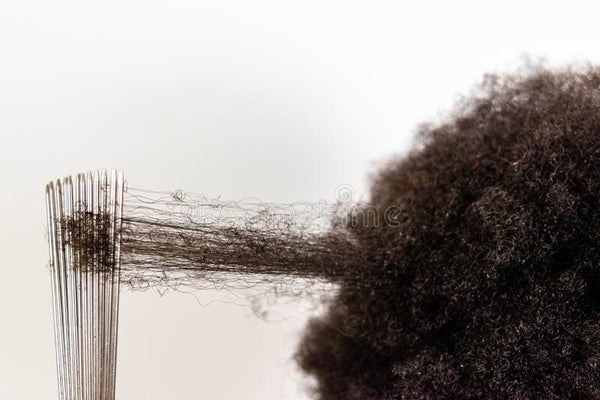5 Things That Contribute to Breakage in Relaxed Hair

We have all spent extra time inspecting every strand of hair in our combs or on the counter to see if there’s breakage or shedding. Before we start, let’s be sure we all know the difference between breakage and shedding.
Shedding occurs when hair has completed it’s growth cycle and falls out from the root. If the hair you find has a white bulb at one end it is most likely shedding. Excess shedding can be controlled by various means.
Breakage however occurs at any point along the hair shaft. Meaning, those small hair you may find on your shoulders or bathroom floor could possibly be broken off pieces of hair. Breakage is the nemesis to all women trying to achieve long, healthy hair.
While some breakage may occur, more than 5 strands could mean a potential problem. If you see more than 10-15 strands at anytime, you are suffering from chronic breakage and need to treat the problem, ASAP. Here are five things that could possibly be contributing to your breakage problem.
1. Improper protein/moisture balance
This is probably the most common problem women experience. Before I began my HHJ, I knew nothing of protein treatments and not much about deep conditioning*.
Now, they are a vital part of my regimen. If you have a relaxer, you should always try to incorporate protein treatments; they return some of the strength your hair lost during the chemical treatment. I alternate between moisture and protein treatments with each wash day and do a heavy protein treatment the week before I get a relaxer. This helps prepare my hair for its chemical assault.

However, protein may not be the issue. I was very displeased to get to my last hair appointment and have my stylist tell me my hair was sorely lacking moisture. Moisture is very important in giving your hair its elasticity.
Lack of moisture can leave the hair dry and brittle. Believe it or not, it is possible to have too much moisture! When the hair has too much moisture, manipulation will cause the strand to over-stretch. This leaves the strand weak at various points which will eventually lead to breakage.
If you are unsure which one is causing you problems, you can perform a wet strand test to assess the condition of your hair.
2. Over-styling
Whenever I style my hair, I am always fixing it here and there, pinning it up, then taking it down, just to put it right back up again. And inevitably, I pin it the same way.
My left side is shorter than the left so I also put more pins on that side. The use of pins puts tension on that part of my hair which can lead to further breakage. If you are pinning up your hair, it would be wise to not put them in the same place everyday. Try using a silk scarf* or seamless headband next time.
If you wear ponytails often, try to move it around so as to not always put tension in the same place. Also, do not pull your hair too tight as this can lead to breakage at the nape and crown. Try to use ponytail holders without the metal piece as these tend to snag hair strands.
3. Too much manipulation
I am as guilty of this as anyone. My hands stay in my head! I can’t help it, it’s a problem. And don’t let me be in front of my mirror, because I will find a stray piece of hair that just has to be brushed into place.
While brushing is beneficial in spreading the natural oils of the scalp, we often brush our hair to force it into a different position. One that usually is not the natural direction of our hair growth. This puts additional pressure on the roots and hair shaft, often resulting in breakage.
Try to minimize the amount of combing and brushing of the hair. Especially when wet! Relaxed hair is at its most vulnerable when wet. Wait until your hair is damp before detangling or any other form of manipulation. And remember to always work your way from the ends to the roots to avoid tangls and knots that will lead to breakage.
 4. Excess heat
4. Excess heat
This relates directly with our first subject. And I’m not just talking about blow dryers*, flat irons*, and curling irons*, even hot water can contribute to your breakage issues. All of these remove moisture from the hair, leaving it dry and brittle.
Overuse of these tools can lead to permanent damage to the hair shaft, at which point breakage is inevitable. Use lukewarm-warm water when washing your hair and minimize heat styling.
There are several other ways to get the same results, for example using rollers or bobby pins* for pincurls. Opt for a bonnet dryer over a blow dryer* or give airdrying a shot, both are less costly and healthier methods of drying hair. If you just have to use heat be sure to use an oil or serum to protect your strands.
5. Overprocessing
This is definitely one to pay attention to if you have chemically treated hair. When applying any chemical to your hair, you should be careful not to overlap the previously processed hair as this can lead to further weakening of the hair shaft.
If you are unsure of whether you can safely apply the solution to your hair and are just against having stylists touch your hair be sure to have a trustworthy friend on hand. Also, be sure to use oil or conditioner to protect your already processed ends.
Overlapping chemical processes is the most common cause of breakage amongst relaxed women. This is why many women stretch their relaxers. Stretching is allowing enough hair to grow so that you can clearly differentiate the new growth from the treated ends.
There are several things that contribute to hair breakage, with these 5 being the most prominent. Your issue may not be on this. If you have tried to solve each of these issues in your hair care regimen and are still experiencing breakage, consult a licensed hair stylist. Your condition may be more drastic than previously thought.
[/mepr-active]




